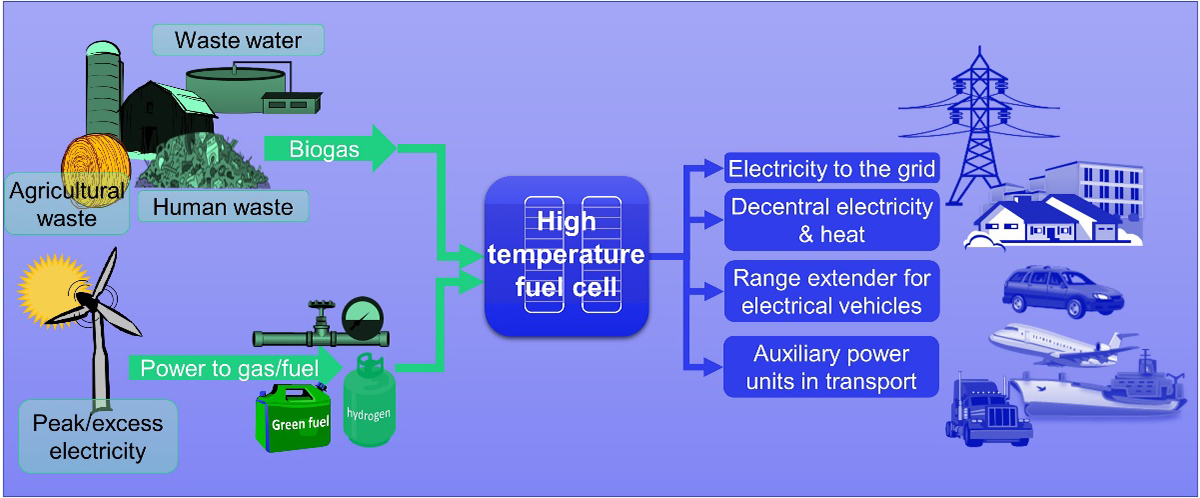Prof Dr Anke Hagen, DTU Energy, highlights the importance of flexible and efficient electricity production as the energy sector continues to lower its greenhouse gas emissions
Climate and environmental concerns have gained a nearly unprecedented public attention worldwide. The reduction of emission of greenhouse gasses – such as CO2 – in order to limit the global warming is among the biggest challenges of modern times. The energy sector, one of the major contributors, is transforming from large central power stations burning fossil fuels towards decentral, distributed units utilising renewable energy sources such as wind and solar.
The sustainable energy system of the future has to accommodate the electricity input from the fluctuating sources and has to provide/distribute electricity according to the consumer profile, also at periods of no wind / no sun, by utilising efficiently all sources of energy. This requires not only smart energy system control but also efficient, flexible technologies for electricity (and heat) production using non-fossil fuels. Setting electricity (and heat) production into focus, the high temperature fuel cell (solid oxide fuel cell – SOFC) is a highly efficient and flexible technology.
In SOFCs, the energy of a fuel such as hydrogen or biogas is converted directly into electricity and heat, which allows for higher electrical efficiencies as compared to combustion based conventional power stations. Values of 50% and higher can be achieved at the system level. The sketch below illustrates examples for the manifold opportunities to apply SOFC technology.
One attractive, non-fossil energy source is biomass and here in particular waste biomass. This includes residues from wastewater treatment, human waste, agricultural waste, etc. Biomass is a large energy source, worldwide. If not stored and used properly, it contributes to the emission of greenhouse gasses (CO2 and methane), for example from open waste disposal sites.Selected fuels and applications for high temperature fuel cells
Biogas from various types of waste is a direct fuel for SOFC, i.e. after a general cleaning step, it does not need further gas treatment or separation. An interesting case is biogas from human waste, which forms naturally in the well-isolated landfill sites. The biogas contains large shares (ca. 50%) of CO2 and is often diluted and thus difficult or impossible to use in combustion engines.
In addition, the specific biogas composition changes over time and depends on the waste type, overall, a challenging fuel to handle. A recent experimental study showed that such biogas is suitable for SOFC, reaching close to 50% electrical efficiency without any optimisation (see full article from A. Hagen, H. Langnickel, X. Sun, title: Operation of Solid Oxide Fuel Cells with Alternative Hydrogen Carriers, published in: Int. J. Hydrogen Energy, 44 (2919) 18382-18392). SOFC is thus a powerful technology to literally convert garbage to a valuable product and reduce greenhouse gas emissions at the same time.
More mature examples of SOFC applications use natural gas – other fuels like hydrogen are possible – in stationary units at different scales. For example, the EU PACE project, sponsored by the Fuel Cells and Hydrogen 2 Joint Undertaking, will install more than 2,800 Fuel Cell micro-Cogeneration units in 10 European countries by 2021 – most of them containing SOFCs. They deliver electricity and heat to houses and small businesses.
In order to reduce CO2 emissions from the transport sector, mainly two solutions are in focus: electrical vehicles and hydrogen fuel cell cars. Their introduction and operation cause significant cost challenges. From a user perspective, the problems of an electrical vehicle are the short ranges and the long fuelling times, while the lack of a sufficient net of hydrogen filling stations is a problem for hydrogen fuel cell cars.
Furthermore, at present most hydrogen is not yet produced via renewable paths but from natural gas – a fossil fuel. SOFC combined with a battery provide an alternative solution. Here the benefit of driving electric unites with a long driving range (several hundreds of km), short fuelling time (few minutes), and dense coverage of fuelling stations from the SOFC side, because they can operate with liquid fuels available from the existing infrastructure. From a society point of view, CO2 emissions are reduced and significant investments saved.
A recent system study including commercial vehicles demonstrated impressively how the battery-SOFC vehicle solution extends the driving range, even for a battery size reduction by 50%, which saves expensive battery materials, production costs, vehicle weight, etc. Ranges close to the ones common for conventional diesel/petrol cars are within reach. The integrated SOFC technology uses liquefied petroleum as fuel and acts a range extender. Other fuels are possible as well, including hydrogen (see full article by Y. Bessekon, P. Zielke, A. C. Wulff, A. Hagen, title: Simulation of a SOFC/Battery powered vehicle, published in: Int. J. Hydrogen Energy 44(3) (2919) 1905-1918).
This hybrid solution already exists in reality. Nissan unveiled a battery-SOFC vehicle during the Olympic Summer Games in Rio de Janeiro in 2016. Owing to the widespread availability of bioethanol in Brazil, the SOFC was developed for the use of this specific fuel, in that way achieving a closed carbon cycle and reducing CO2 emissions. Apart from extending the range of vehicles, SOFCs are also attractive to deliver electricity to trucks or ships using on board fuel and avoiding emissions of particles or toxic nitrous oxides as it is the case when an idling motor provides the electricity.
SOFC technology holds key advantages for shaping a flexible, sustainable energy system, both, in stationary and transport applications. The fuel flexibility and possible high electrical efficiencies allow for reduction of greenhouse gas emissions during electricity production, for delivery of electricity to numerous applications according to the desired consumer profile, and for saving of significant investments by utilising of existing fuel opportunities at present and in the future (biogas, hydrogen, etc.).
Please note: This is a commercial profile












